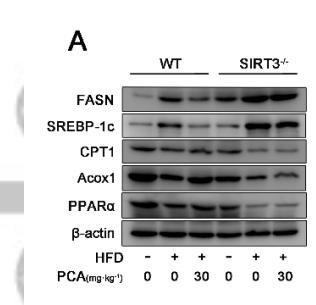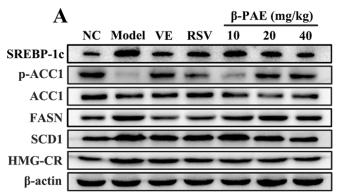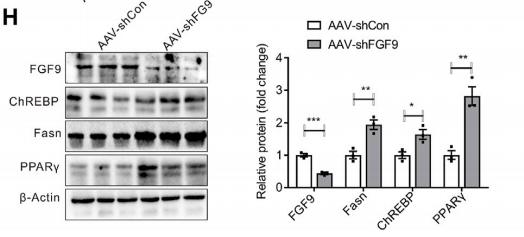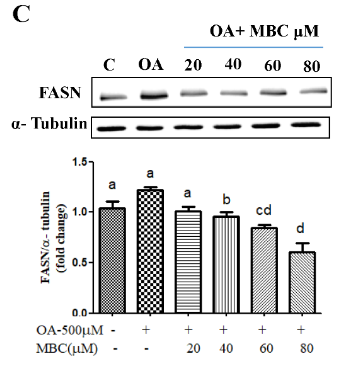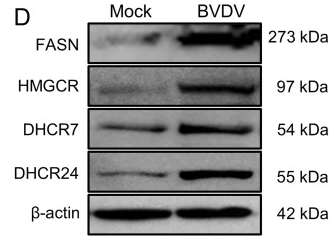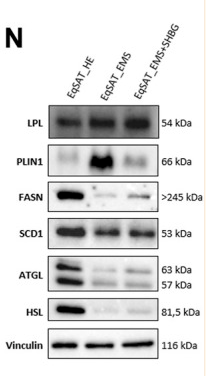FASN Antibody - #DF6106
| 製品: | FASN Antibody |
| カタログ: | DF6106 |
| タンパク質の説明: | Rabbit polyclonal antibody to FASN |
| アプリケーション: | WB IHC |
| Cited expt.: | WB, IHC |
| 反応性: | Human, Mouse, Rat |
| 予測: | Zebrafish, Bovine, Horse, Dog |
| 分子量: | 272kDa; 273kD(Calculated). |
| ユニプロット: | P49327 |
| RRID: | AB_2811172 |
製品説明
*The optimal dilutions should be determined by the end user. For optimal experimental results, antibody reuse is not recommended.
*Tips:
WB: For western blot detection of denatured protein samples. IHC: For immunohistochemical detection of paraffin sections (IHC-p) or frozen sections (IHC-f) of tissue samples. IF/ICC: For immunofluorescence detection of cell samples. ELISA(peptide): For ELISA detection of antigenic peptide.
引用形式: Affinity Biosciences Cat# DF6106, RRID:AB_2811172.
折りたたみ/展開
[Acyl-carrier-protein] S acetyltransferase; [Acyl-carrier-protein] S malonyltransferase; 3-hydroxypalmitoyl-[acyl-carrier-protein] dehydratase; 3-oxoacyl-[acyl-carrier-protein] reductase; 3-oxoacyl-[acyl-carrier-protein] synthase; Enoyl-[acyl-carrier-protein] reductase; FAS; FAS_HUMAN; FASN; Fatty acid synthase; MGC14367; MGC15706; OA 519; Oleoyl-[acyl-carrier-protein] hydrolase; SDR27X1; Short chain dehydrogenase/reductase family 27X member 1;
免疫原
A synthesized peptide derived from human FASN, corresponding to a region within N-terminal amino acids.
- P49327 FAS_HUMAN:
- Protein BLAST With
- NCBI/
- ExPASy/
- Uniprot
MEEVVIAGMSGKLPESENLQEFWDNLIGGVDMVTDDDRRWKAGLYGLPRRSGKLKDLSRFDASFFGVHPKQAHTMDPQLRLLLEVTYEAIVDGGINPDSLRGTHTGVWVGVSGSETSEALSRDPETLVGYSMVGCQRAMMANRLSFFFDFRGPSIALDTACSSSLMALQNAYQAIHSGQCPAAIVGGINVLLKPNTSVQFLRLGMLSPEGTCKAFDTAGNGYCRSEGVVAVLLTKKSLARRVYATILNAGTNTDGFKEQGVTFPSGDIQEQLIRSLYQSAGVAPESFEYIEAHGTGTKVGDPQELNGITRALCATRQEPLLIGSTKSNMGHPEPASGLAALAKVLLSLEHGLWAPNLHFHSPNPEIPALLDGRLQVVDQPLPVRGGNVGINSFGFGGSNVHIILRPNTQPPPAPAPHATLPRLLRASGRTPEAVQKLLEQGLRHSQDLAFLSMLNDIAAVPATAMPFRGYAVLGGERGGPEVQQVPAGERPLWFICSGMGTQWRGMGLSLMRLDRFRDSILRSDEAVKPFGLKVSQLLLSTDESTFDDIVHSFVSLTAIQIGLIDLLSCMGLRPDGIVGHSLGEVACGYADGCLSQEEAVLAAYWRGQCIKEAHLPPGAMAAVGLSWEECKQRCPPGVVPACHNSKDTVTISGPQAPVFEFVEQLRKEGVFAKEVRTGGMAFHSYFMEAIAPPLLQELKKVIREPKPRSARWLSTSIPEAQWHSSLARTSSAEYNVNNLVSPVLFQEALWHVPEHAVVLEIAPHALLQAVLKRGLKPSCTIIPLMKKDHRDNLEFFLAGIGRLHLSGIDANPNALFPPVEFPAPRGTPLISPLIKWDHSLAWDVPAAEDFPNGSGSPSAAIYNIDTSSESPDHYLVDHTLDGRVLFPATGYLSIVWKTLARALGLGVEQLPVVFEDVVLHQATILPKTGTVSLEVRLLEASRAFEVSENGNLVVSGKVYQWDDPDPRLFDHPESPTPNPTEPLFLAQAEVYKELRLRGYDYGPHFQGILEASLEGDSGRLLWKDNWVSFMDTMLQMSILGSAKHGLYLPTRVTAIHIDPATHRQKLYTLQDKAQVADVVVSRWLRVTVAGGVHISGLHTESAPRRQQEQQVPILEKFCFTPHTEEGCLSERAALQEELQLCKGLVQALQTKVTQQGLKMVVPGLDGAQIPRDPSQQELPRLLSAACRLQLNGNLQLELAQVLAQERPKLPEDPLLSGLLDSPALKACLDTAVENMPSLKMKVVEVLAGHGHLYSRIPGLLSPHPLLQLSYTATDRHPQALEAAQAELQQHDVAQGQWDPADPAPSALGSADLLVCNCAVAALGDPASALSNMVAALREGGFLLLHTLLRGHPLGDIVAFLTSTEPQYGQGILSQDAWESLFSRVSLRLVGLKKSFYGSTLFLCRRPTPQDSPIFLPVDDTSFRWVESLKGILADEDSSRPVWLKAINCATSGVVGLVNCLRREPGGNRLRCVLLSNLSSTSHVPEVDPGSAELQKVLQGDLVMNVYRDGAWGAFRHFLLEEDKPEEPTAHAFVSTLTRGDLSSIRWVCSSLRHAQPTCPGAQLCTVYYASLNFRDIMLATGKLSPDAIPGKWTSQDSLLGMEFSGRDASGKRVMGLVPAKGLATSVLLSPDFLWDVPSNWTLEEAASVPVVYSTAYYALVVRGRVRPGETLLIHSGSGGVGQAAIAIALSLGCRVFTTVGSAEKRAYLQARFPQLDSTSFANSRDTSFEQHVLWHTGGKGVDLVLNSLAEEKLQASVRCLATHGRFLEIGKFDLSQNHPLGMAIFLKNVTFHGVLLDAFFNESSADWREVWALVQAGIRDGVVRPLKCTVFHGAQVEDAFRYMAQGKHIGKVVVQVLAEEPEAVLKGAKPKLMSAISKTFCPAHKSYIIAGGLGGFGLELAQWLIQRGVQKLVLTSRSGIRTGYQAKQVRRWRRQGVQVQVSTSNISSLEGARGLIAEAAQLGPVGGVFNLAVVLRDGLLENQTPEFFQDVCKPKYSGTLNLDRVTREACPELDYFVVFSSVSCGRGNAGQSNYGFANSAMERICEKRRHEGLPGLAVQWGAIGDVGILVETMSTNDTIVSGTLPQRMASCLEVLDLFLNQPHMVLSSFVLAEKAAAYRDRDSQRDLVEAVAHILGIRDLAAVNLDSSLADLGLDSLMSVEVRQTLERELNLVLSVREVRQLTLRKLQELSSKADEASELACPTPKEDGLAQQQTQLNLRSLLVNPEGPTLMRLNSVQSSERPLFLVHPIEGSTTVFHSLASRLSIPTYGLQCTRAAPLDSIHSLAAYYIDCIRQVQPEGPYRVAGYSYGACVAFEMCSQLQAQQSPAPTHNSLFLFDGSPTYVLAYTQSYRAKLTPGCEAEAETEAICFFVQQFTDMEHNRVLEALLPLKGLEERVAAAVDLIIKSHQGLDRQELSFAARSFYYKLRAAEQYTPKAKYHGNVMLLRAKTGGAYGEDLGADYNLSQVCDGKVSVHVIEGDHRTLLEGSGLESIISIIHSSLAEPRVSVREG
種類予測
Score>80(red) has high confidence and is suggested to be used for WB detection. *The prediction model is mainly based on the alignment of immunogen sequences, the results are for reference only, not as the basis of quality assurance.
High(score>80) Medium(80>score>50) Low(score<50) No confidence
研究背景
Fatty acid synthetase catalyzes the formation of long-chain fatty acids from acetyl-CoA, malonyl-CoA and NADPH. This multifunctional protein has 7 catalytic activities as an acyl carrier protein.
Cytoplasm. Melanosome.
Note: Identified by mass spectrometry in melanosome fractions from stage I to stage IV.
Ubiquitous. Prominent expression in brain, lung, and liver.
研究領域
· Environmental Information Processing > Signal transduction > AMPK signaling pathway. (View pathway)
· Metabolism > Lipid metabolism > Fatty acid biosynthesis.
· Metabolism > Global and overview maps > Metabolic pathways.
· Metabolism > Global and overview maps > Fatty acid metabolism.
· Organismal Systems > Endocrine system > Insulin signaling pathway. (View pathway)
参考文献
Application: WB Species: Rat Sample: hepatic tissue
Application: WB Species: Mouse Sample: livers
Application: IHC Species: Mouse Sample:
Application: WB Species: Human Sample: SK-HEP-1 cells
Application: WB Species: mouse Sample: liver
Application: WB Species: Human Sample: adipose tissue
Restrictive clause
Affinity Biosciences tests all products strictly. Citations are provided as a resource for additional applications that have not been validated by Affinity Biosciences. Please choose the appropriate format for each application and consult Materials and Methods sections for additional details about the use of any product in these publications.
For Research Use Only.
Not for use in diagnostic or therapeutic procedures. Not for resale. Not for distribution without written consent. Affinity Biosciences will not be held responsible for patent infringement or other violations that may occur with the use of our products. Affinity Biosciences, Affinity Biosciences Logo and all other trademarks are the property of Affinity Biosciences LTD.
